Wight Conservation - Habitats
Farming for wildlife is all about creating, enhancing or maintaining habitats. Without habitats, there is no wildlife. Some wildlife has become endangered or rare through a combination of loss or damage to habitats, or climatic change. At Wight Conservation, all our effort is devoted towards habitat management. We are fortunate and unusual that we have such a wide variety of habitat on only 1400 acres in hand. Our principal habitats include chalk grassland, heathland, ancient woodland, hedgerows and traditional stone farm buildings. The many endangered, threatened or nationally rare species of flora and fauna to be found in them emphasizes the importance of our estate for conservation.
The well known IW naturalist, the late Oliver Frazer, wrote, "If you come from anywhere in south-east England, you will surely find some parts of the Island which is just like home. This is the secret. Owing to its varied geology, the Island is a mircorcosm of all that is found in south-east England (and a lot more besides), compressed and squeezed into an area less than one tenth the size of Hampshire."
Our habitats are summarised below:
Managed Woodland
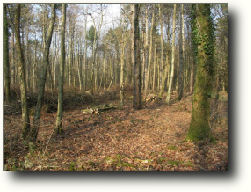 Managed woodland offers a great diversity of habitats which
hosts a whole range of mammals, birds, invertebrates, amphibians,
trees and plant life. Conversely, unmanaged woodland greatly
reduces the habitat potential. Managed woodland offers a great diversity of habitats which
hosts a whole range of mammals, birds, invertebrates, amphibians,
trees and plant life. Conversely, unmanaged woodland greatly
reduces the habitat potential.
An open canopy allows individual trees to prosper and develop. Veteran trees can live out their "retirement" free of damaging competition from neighbours.
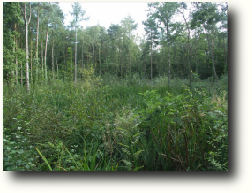 The open canopy also lets in sunlight onto the forest floor allowing its ground vegetation, especially in ancient woodlands, shrub layer and under storey to develop and provide food sources for the red squirrels, dormice, birds and insects. A food chain develops. The open canopy also lets in sunlight onto the forest floor allowing its ground vegetation, especially in ancient woodlands, shrub layer and under storey to develop and provide food sources for the red squirrels, dormice, birds and insects. A food chain develops.
The undergrowth provides shelter for mammals such as the fox, hare and rabbit.
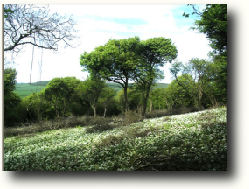 Hazel coppice harvested on a rotational basis is an important habitat. For the first three years after coppicing,
there is a dramatic increase in sunlight onto the forest floor
in spring and summer, encouraging violets, primroses, bluebells Hazel coppice harvested on a rotational basis is an important habitat. For the first three years after coppicing,
there is a dramatic increase in sunlight onto the forest floor
in spring and summer, encouraging violets, primroses, bluebells
and other attractive flowers. As the coppice grows, it shades
out many of these species and only a handful of the hardier continue to prosper. The open ground, with its own micro climate, gives good conditions for many forest floor invertebrates to thrive, but their habitat reduces as the hazel growth shades out the floor in years five onwards.
Years two to five after coppicing provide optimum conditions for many species of butterfly and we have seen a welcome re-emergence of the pearl bordered fritillary in areas now under coppice management. After about year five, the overall habitat value declines sharply.
A number of bird species respond to coppicing, especially between three and ten years after cutting. We have welcomed the return of the nightingale after many years absence.
Wood mice, shrews and bank voles thrive in the earlier years after coppicing and, although declining as the shade increases, continue to inhabit the area until the next felling.
Hazel nuts are an ideal food source for the red squirrel and dormouse. On the Isle of Wight, hazel starts fruiting in its third year, but it is at its best for these species between 15 and 18 years. Thereafter its value as a food source decreases.
Ideally, except for the red squirrel and the dormouse, hazel should be rotationally re-coppiced every five to seven years. Nowadays, however, coppicing skills and the demand for coppice products have sharply declined. Hence our decision to re-coppice every 15 to 18 years. If left after that, it becomes increasingly derelict. The forest floor is totally shaded out, it becomes leggy and spindly, and its fruit carrying capacity declines. Its habitat value is greatly diminished.
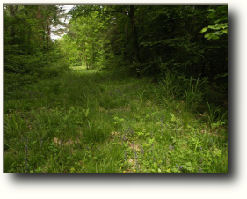 The more woodland edge there is, the better it is for wildlife as it allows more sunlight in. Woodland edges include rides and glades, with the east-west rides being the most beneficial as they are more exposed to the sun. Many species of flowers thrive on the sunny edges and in these days of intensive farming, for some they are the last outposts of survival. Sunlight and a diverse vegetation offer The more woodland edge there is, the better it is for wildlife as it allows more sunlight in. Woodland edges include rides and glades, with the east-west rides being the most beneficial as they are more exposed to the sun. Many species of flowers thrive on the sunny edges and in these days of intensive farming, for some they are the last outposts of survival. Sunlight and a diverse vegetation offer
good opportunities for a huge number of insects. Woodland edges are important for butterflies - the greater the openness, the more sunshine and the greater the variety, although there are still species which are dependent upon more shady conditions. Hence, narrower rides can be just as important as the wider.
The red squirrel enjoys the wide rides for foraging because the openness gives it security from some predators. Bats enjoy rides as foraging highways, swooping along them, and devouring insects without having to constantly twist and turn to avoid trees and branches.
Veteran trees are an important habitat for many species of bats, birds, invertebrates, fungi and mosses. It is therefore vital that the veterans are respected. Similarly,
even if they die or shed limbs, both standing and fallen deadwood remain a valued habitat.
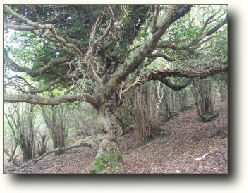
Veteran Field Maple |
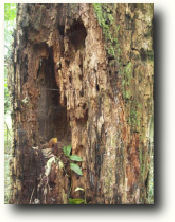
Standing Dead wood |
Chalk Grassland
True chalk grassland is "unimproved" - i.e. it is historically untreated by any fertilizers or pesticides. The sward is made up of a large variety of grass and herb species, many of which are only found on chalk.
A wide variety of wild flowers colonise chalk grassland, examples being the early gentian and a host of orchids. Butterflies such as the Adonis blue and chalk hill blue are found. And there are adders!
Grazing by either hardy cattle or sheep is important to maintain the grassland at its optimum. Due to agricultural and forestry demands, the Island has lost nearly 90% of its chalk grassland. It remains still plentiful at Wroxall where it is being carefully managed. Wight Conservation is restoring it from former forestry at Mottistone Down and Idlecombe Down.
Heathland
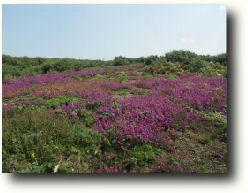 Lowland heathland and more especially chalk heathland
are rare, disappearing habitats, having declined by over 90% on the Island. They have great ecological value.
Heathland plants include bell heather, ling heather, gorse
and different species of wild flowers and grasses. Nightjars,
dartford warblers and yellowerhammer are among the more interesting bird species inhabiting heathland. Invertebrate surveys have shown our heathland to be particularly valuable for many endangered or nationally scarce species. Adders and lizards enjoy the habitat; rabbits, foxes and badgers are common. Lowland heathland and more especially chalk heathland
are rare, disappearing habitats, having declined by over 90% on the Island. They have great ecological value.
Heathland plants include bell heather, ling heather, gorse
and different species of wild flowers and grasses. Nightjars,
dartford warblers and yellowerhammer are among the more interesting bird species inhabiting heathland. Invertebrate surveys have shown our heathland to be particularly valuable for many endangered or nationally scarce species. Adders and lizards enjoy the habitat; rabbits, foxes and badgers are common.
To prevent it becoming over grown and shutting out the less competitive species, regular management is required to retain its mosaic features. Wight Conservation is restoring former heathland from forestry at Mottistone Common, Brighstone Down and Idlecombe Down.
Gorse
Although frequently found on both chalk grassland and heathland, such is its importance to us that it is mentioned as a habitat in its own right. It is home to the dartford warbler, amongst others, and dormice 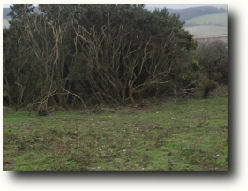 have been found snuggled up in it. Many insects thrive there and on dewy mornings it dramatically supports a mass of spiders’ webs. Like hazel coppice, it responds to rotational management and needs have been found snuggled up in it. Many insects thrive there and on dewy mornings it dramatically supports a mass of spiders’ webs. Like hazel coppice, it responds to rotational management and needs
to be cut or burnt about every 10 years. Should it be allowed
to become tall and leggy, it looses most of its habitat value.
Blocks of gorse are a good habitat for the fox.
On Wight Conservation’s estate, gorse is found on St Martin’s Down, Wroxall Down, Mottistone Common, Brighstone Down, Mottistone Down and Idlecombe Down.
Bramble
All things in moderation. In patches, and provided it is not too much of a monoculture, bramble can be an excellent habitat. Its flowers, berries and nectar are a good food source for many bird species, butterflies and insects. To keep it at its best, it needs to be cut regularly and preferably “moved on”.
Lowland Pastures
If intensively grazed, regularly mown or fertilized, lowland grassland is a poor habitat. On the other hand, if it is extensively grazed with the minimum of fertilizer, allowed to develop into a tussocky sward, then it becomes home for wild flowers and many insects. It is appreciated for its food sources by many bird species and the hare. When managed in this way, it provides a good habitat for voles, shrews and other small mammals, thus making it a good hunting ground for the barn owl.
Hedgerows
Not only are they visually attractive, but hedgerows are an important feature if bird life is to be encouraged. It needs to be trimmed about every three years and, if allowed to grow too high, should be periodically cut and laid or coppiced. Both, however, are an extensive process.
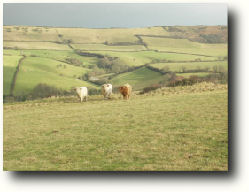
Hedgerows, Wroxall Manor Farm
|
Different types of hedge attract different types of bird species. The yellowhammer, for example, prefers short, wide hedges, while some others like them tall and bushy. The farm should ideally have several different sized hedges to appeal to a wide range of birds.
Hedgerows make good communication corridors between woodlands for the red squirrel and the dormouse. Without them, woods can become fragmented, thus reducing their habitat importance.
Our fields are all grass, and, if topped, margins are left on either side of a hedge to allow rough vegetative edges to grow. These provide good habitats for small mammals and insects, thus improving the food sources for birds.
Set-aside
Because Wroxall Manor Farm was once arable, a proportion still has to be kept as permanent set-aside, that is it must not be used for grazing between the 15th January and 31st August, and nor for any other agricultural production.
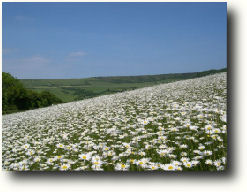 In the early days of set-aside, it had to be mown mid summer
to ensure that no illicit crops were being grown. The Prince
of Wales, to his credit, had the vision to see the damage
to wildlife being caused and was principally responsible
for lobbying that it be left until between 15th July and
15th August when it now has to be mown. Our set-aside is now habitat for pyramidal orchids, many bird species, and hares. In the early days of set-aside, it had to be mown mid summer
to ensure that no illicit crops were being grown. The Prince
of Wales, to his credit, had the vision to see the damage
to wildlife being caused and was principally responsible
for lobbying that it be left until between 15th July and
15th August when it now has to be mown. Our set-aside is now habitat for pyramidal orchids, many bird species, and hares.
Woodland Ponds
Woodland ponds are a feature of our estate. The rare great crested newts have been found at two. At nighttime in the summer they attract such insect activity that they are a popular hunting ground for bats. In dry summers, they are badly needed watering holes
for foxes and badgers.
Water Courses
We have brooks bordering Rowlands Wood and Chillingwood, and there is a small spring-fed stream at Wroxall Manor Farm. As yet, we have made no surveys of the wildlife they support, but there is no reason to believe that the brooks at Rowlands Wood and Chillingwood are not suitable for the water vole.
Dry Stone Walls
There are a small number of dry stone walls which offer nesting places for some species of birds and bats. They might be used by lizards, and will be home to several invertebrate species, as well as some wild flowers.
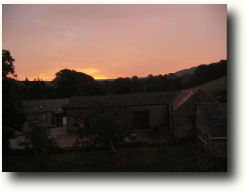
Farm buildings at sunrise |
Farm Buildings
At Wroxall Manor Farm and Rew, many of the old farm
buildings are of traditional stone. Care is taken in their
maintenance and constantly they offer good habitat for
farm yard birds like the swallow and owls. They are also
favoured by certain bat species like the pipistrelle.
Highland Cattle
Surprisingly, we include Highland cattle as a habitat. Their long, shaggy winter coats, once shed, provide material for birds to make their nests. In the spring, birds are seen on their backs, picking out the monthly winter coats. From late spring onwards, their grazing includes wild flower seeds and as they range in their foraging, their dung deposits the seeds elsewhere on the farm. The dung itself becomes a habitat for beetles and other invertebrates, as well as a food source for birds and foxes.

Conclusion
Wight Conservation still has a long way to go in learning which species best react to our farmland management. Little or nothing is known about our fungi, lichens, mosses, moths, small mammals, reptiles, amphibians, beetles, crickets, dragonflies, spiders etc. It is all a question of time and money. We are entirely privately funded for searching this knowledge.
All habitats require management and care. We will continue to do this to our best of our ability. Conservation is still more of an art than a science. We are learning and breaking new ground the whole time. It does not, by any means, always go to plan and we make many mistakes. One consolation, however, is that our mistakes bring benefits in other unforeseen directions.
As a matter of principle, we do not artificially feed our wildlife, nor do we put out nesting boxes. The sole exception is boxes for barn owls to replace barn areas which have been converted to accommodation, or previously demolished because of age. We prefer to let nature have its own way, even in difficult times. After all, nature has its own cycle.
|